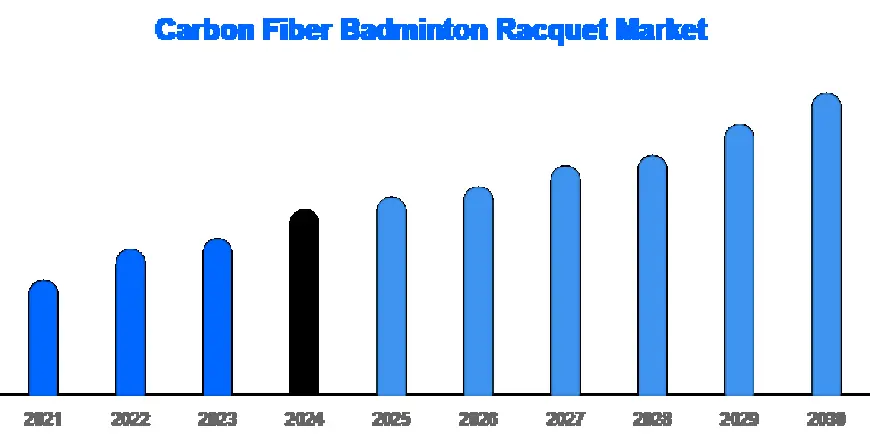Global Carbon Fiber Badminton Racquet Market Size, Share, Demand & Trends Analysis by 2030
The carbon fiber badminton racquet market size was valued at USD 456.2 million in 2024, and it is projected to reach USD 692.7 million by 2030, exhibiting a CAGR of 7.2% during the forecast period (2025-2030).

Carbon Fiber Badminton Racquet Market: Landscape, Trends, and Future Outlook
Market Overview
The carbon fiber badminton racquet market size was valued at USD 456.2 million in 2024, and it is projected to reach USD 692.7 million by 2030, exhibiting a CAGR of 7.2% during the forecast period (2025-2030).
Regional Insights
Asia‑Pacific leads the global market with the largest share, driven by the sport's immense popularity in countries such as China, India, Indonesia, and Japan. This region benefits from a strong tradition of badminton, extensive player base, and growing investments in training academies and sports infrastructure. North America is steadily growing as badminton gains traction among youth and fitness enthusiasts. Europe also shows consistent expansion with rising participation rates and organized sporting events. Emerging regions such as Latin America and the Middle East are gradually building their presence through gradual urbanization and growing interest in badminton.
Key Market Drivers
Carbon fiber rackets offer a superior strength-to-weight ratio, enabling faster swing speeds, better control, and greater durability compared to traditional materials. This makes them highly appealing to both professional and recreational players. Technological innovations such as nanotechnology, advanced composites, improved shaft flexibility, and aerodynamic frame designs enhance gameplay and player comfort. Additionally, rising disposable incomes and growing fitness awareness have led to more consumers investing in premium sports equipment.
As badminton becomes more visible through international tournaments and grassroots promotions, demand for high-performance racquets continues to rise. These trends are supported further by endorsements from top athletes and expanding global recognition of badminton as an accessible sport for all ages.
Market Segments and Applications
The market is segmented by product type, application, end-user demographics, and distribution channel. Lightweight racquets (often below 75 grams) are favored by professional and advanced players seeking agility and responsiveness. Heavier racquets prioritize power and stability and remain popular among beginners and intermediate users.
Applications span professional athletes, amateur and recreational players, and junior or youth segments. On the consumer side, men currently form the largest group of users, followed by growing demand among women and children.
Distribution channels include online platforms, specialty sports stores, supermarkets, hypermarkets, and general retail. Online sales are gaining momentum due to convenience, broader product selection, and international access, while physical stores remain critical for try-before-buy experiences.
Challenges and Restraints
Despite strong demand, the industry faces challenges. High production costs and premium pricing of carbon fiber racquets limit accessibility for budget-conscious players, especially in emerging markets. The market is also fragmented with considerable competition from counterfeit products, which can dilute brand value and consumer trust. Additionally, many recreational players lack awareness of the performance benefits of carbon fiber technology, slowing adoption outside elite circles.
Emerging Trends and Opportunities
Personalization and customization are emerging as key trends. Leading brands now offer options for grip size, shaft stiffness, balance, and aesthetic design tailored to player preferences. Sustainability is increasingly important, with manufacturers exploring eco-friendly carbon composites and modular designs for durability and reduced waste.
Smart racquet technologies, including sensors that track swing metrics, are also gaining traction among data-conscious and performance-focused users. The rise of multi-functional racquets combining lightweight flexibility with power features addresses varying playing styles and skill levels. Brands are leveraging partnerships with professional players and sponsoring events to build credibility and global reach.
Future Outlook
The carbon fiber badminton racquet market is poised for continued growth through 2030 and beyond. With innovation in advanced materials and customization, combined with the rising popularity of badminton globally, demand for high-performance equipment will continue to expand. Asia‑Pacific is expected to remain the dominant region, while Western markets grow steadily. Success in this sector will depend on offering accessible product tiers, transparent communication of performance benefits, and investments in user education and brand trust.
About Deep Market Insights
Deep Market Insights is a leading global market research and consulting firm dedicated to delivering accurate, data-driven intelligence across diverse industries. Our mission is to empower businesses with reliable market analysis, enabling smarter decisions and long-term growth.
What's Your Reaction?
 Like
0
Like
0
 Dislike
0
Dislike
0
 Love
0
Love
0
 Funny
0
Funny
0
 Angry
0
Angry
0
 Sad
0
Sad
0
 Wow
0
Wow
0



















































